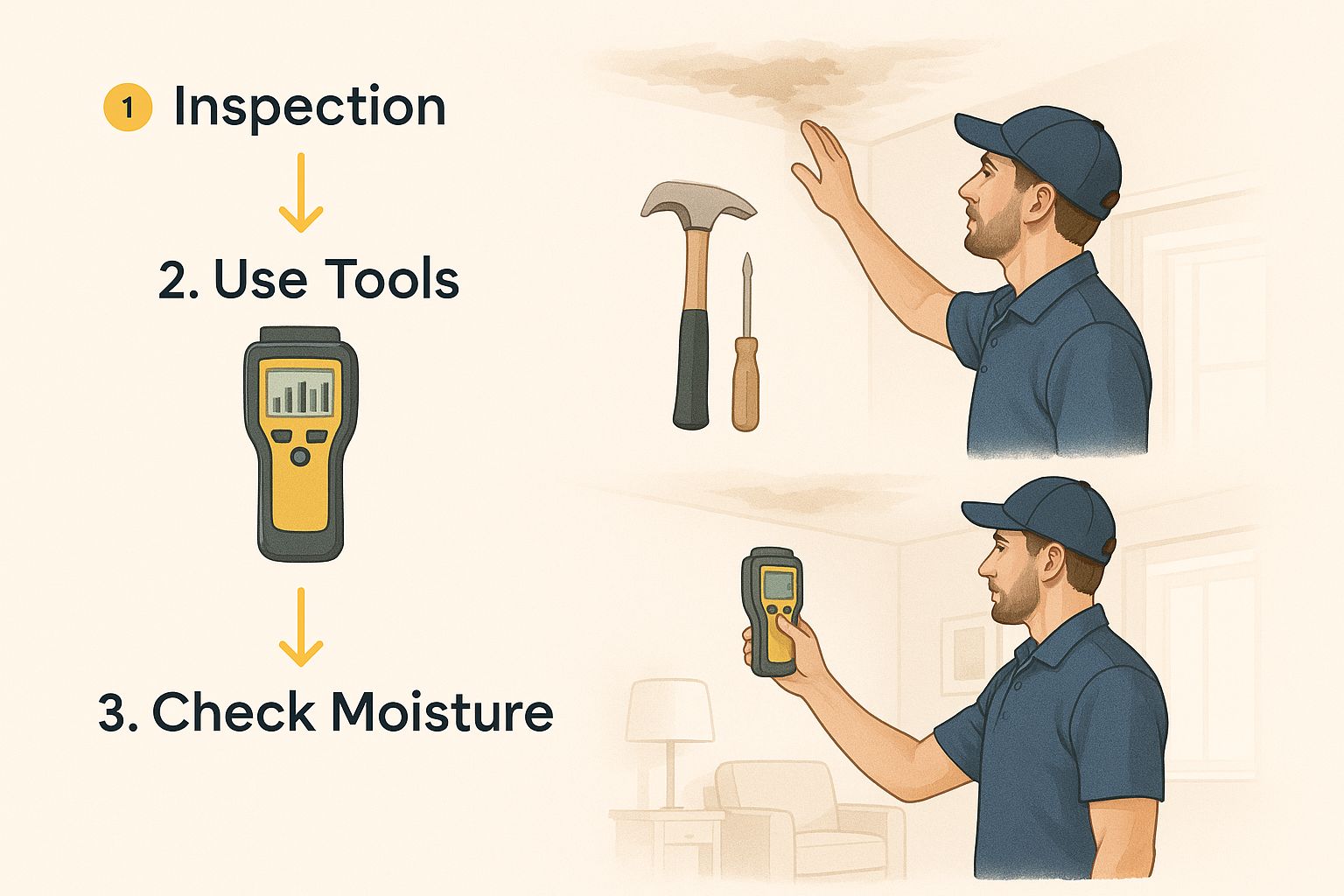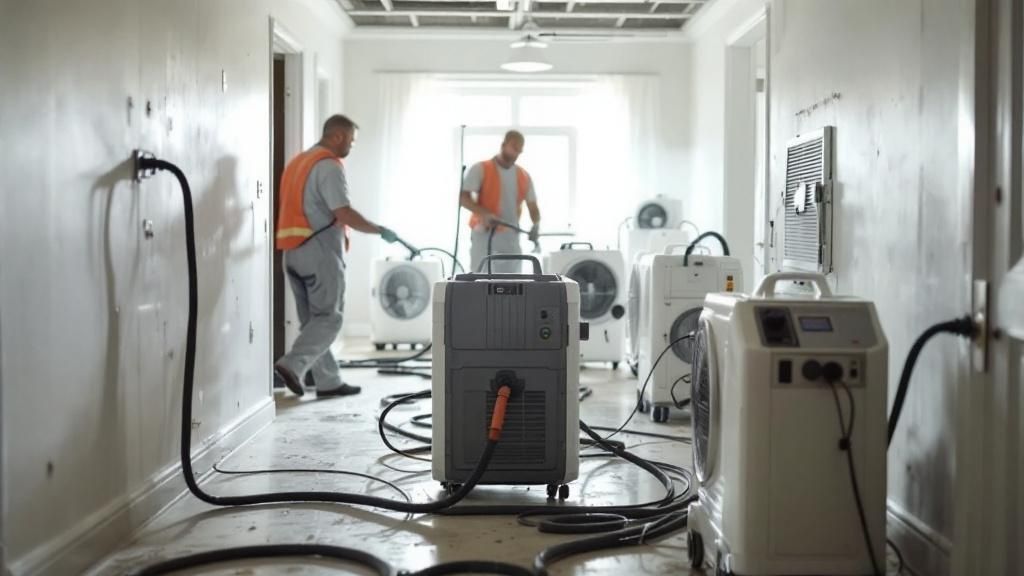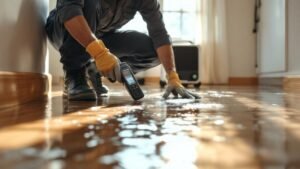When you first spot a leak or walk into a flooded room, your heart sinks. The initial shock of finding water damage, whether from a burst pipe in your Sherman Oaks kitchen or a roof leak after a rare Los Angeles downpour, can be overwhelming. But what you do in that first hour is absolutely critical. Acting fast isn’t just about saving money—it’s about protecting your property and your family from further harm. This guide will walk you through the essential steps to take and how to find a reliable water damage restoration company near me that you can trust.
If you’re facing an emergency now, don’t wait. Call our 24/7 team for immediate help.
Get a Free Assessment Now
The Hidden Dangers of Lingering Water Damage
Panic is the first thing you’ll feel, but a clear head will serve you best. The decisions you make before the pros even get there are just as important as the restoration work itself. Your focus needs to be on three things: safety, stopping the water, and documenting the mess for your insurance company. Lingering water can lead to serious secondary issues, including structural rot and, most importantly, mold growth, which can begin in as little as 24-48 hours.
Safety First, Then Stop the Source
Before you even think about grabbing a mop, deal with the immediate dangers. If there’s standing water, the first and most important step is to shut off the electricity at the breaker box. Water and electricity are a deadly combination.
Once it’s safe, your next mission is to stop the flow of water. If you can easily spot the source—a burst pipe under the sink or an overflowing toilet—shut off the main water valve to your house immediately.
This infographic shows a technician using specialized tools to check a water-damaged ceiling for hidden moisture, a perfect example of why professional help is necessary.

What you see on the surface is often just the tip of the iceberg. The real damage from a water heater failure in a Santa Monica condo or a slab leak in a Van Nuys home is usually hiding where you can’t see it.
To help you stay focused during a stressful moment, here’s a quick checklist of what to do right away.
Immediate Water Damage Response Checklist
This table provides a simple, priority-based guide for your initial actions. Following these steps can help ensure your safety and minimize the extent of the damage before professionals arrive.
| Priority | Action Item | Reason |
|---|---|---|
| 1 (Critical) | Shut off electricity at the breaker box. | Prevents risk of electrocution from standing water. |
| 2 (Critical) | Shut off the main water valve. | Stops the source of the leak to prevent further flooding. |
| 3 (High) | Move valuables and electronics. | Protects irreplaceable items from being destroyed. |
| 4 (High) | Take photos and videos of everything. | Provides crucial evidence for your insurance claim. |
| 5 (Medium) | Elevate furniture off wet carpets. | Prevents permanent stains and rust marks. |
Having this list handy can make all the difference when you’re under pressure and not thinking clearly.
Protect and Document
After you’ve made the area safe, start moving what you can. Get furniture, electronics, and important papers to a dry, safe spot. A simple but effective trick is to place small pieces of aluminum foil or wood blocks under the legs of heavy furniture. This small step can prevent nasty stains and rust marks from ruining your carpet.
Crucial Tip: Don’t wait to start documenting. Pull out your phone and take tons of photos and videos. Get shots of the affected rooms, close-ups of damaged items, and the source of the water if you can. This visual proof is pure gold when you file your insurance claim.
Property damage incidents are unfortunately on the rise. In recent years, the U.S. has seen an average of 20 billion-dollar weather disasters annually, with water damage being a huge part of the fallout. You can learn more about the trends in the property restoration industry on purocleanfranchise.com.
These numbers aren’t meant to scare you, but to highlight how important it is to have a plan and find a reliable water damage restoration company near me before you even need one. As you’re taking these first steps, now is the perfect time to call an emergency water damage restoration team in Los Angeles and get professional help on the way.
How to Choose the Right Water Damage Restoration Company
When your home is flooded, the last thing you need is a “restoration” company that makes things worse. Honestly, anyone can buy a few fans, rent a truck, and call themselves an expert. You need to look past the slick website and find the real pros.
The single most important thing to look for is IICRC certification. This isn’t just a fancy acronym; the Institute of Inspection, Cleaning and Restoration Certification is the organization that sets the global standard for our industry. If a company’s technicians are IICRC-certified, it means they’ve been trained and tested on the science of drying, cleaning, and restoring a property correctly. It’s a non-negotiable credential.
The Must-Haves: Licenses and Insurance
Beyond certifications, any legitimate company operating in California must be fully licensed and insured. Don’t be shy about this—ask for their state contractor’s license number and look it up yourself. This simple step weeds out the unqualified operators immediately.
Insurance is just as critical. A professional outfit will always carry two specific types of coverage:
- General Liability Insurance: This is what protects your home and belongings from any accidental damage that might happen while the crew is working.
- Workers’ Compensation Insurance: This policy is crucial. It protects you from being on the hook financially if one of their technicians gets injured on your property.
A company that hesitates or can’t immediately provide proof of both license and insurance is a massive red flag. Don’t walk away—run. Hiring them could leave you completely exposed to huge financial risks.
Reading Between the Lines of Online Reviews
Online reviews are a great starting point, but you have to learn how to read them. A star rating doesn’t tell the whole story. Instead, dig into the written feedback and look for patterns.
Are people consistently mentioning great communication, showing up on time, and professional behavior? Or do you see repeated complaints about surprise charges, sloppy work, or crews that disappeared mid-job?
Look for reviews that describe a real-world scenario, like a burst pipe in their kitchen or a major roof leak after a storm. These detailed accounts give you a much better feel for how the company performs under pressure. For more on this, check out our in-depth guide on how to choose the right restoration company in Los Angeles.
Finally, take it offline. Ask the company for a few local references—and then actually call them. A company that’s proud of its work will have a list of happy clients ready to go. When you talk to them, ask specific questions like, “How did they handle working with your insurance company?” or “Were there any costs at the end that you didn’t expect?” Their answers will tell you everything you need to know.
The Professional Water Damage Restoration Process Explained
When the pros roll up, things can get hectic fast. But there’s a method to the madness. A professional restoration team follows a proven process to stop the damage in its tracks, thoroughly dry everything out, and get your home back to normal. Knowing what’s happening can make a stressful situation feel a lot more manageable.
It all starts with a detailed inspection. The first thing technicians will do is figure out exactly where the water went. They’re not just looking for puddles; they use professional tools like moisture meters and thermal imaging cameras to find hidden water behind walls, under floors, and soaked into insulation. This step is non-negotiable—missed moisture is a recipe for mold and long-term structural problems.
Getting the Water Out and Clearing the Debris
With the damage mapped out, the crew gets to work on extraction. They’ll bring in the heavy-duty gear, like truck-mounted vacuums and powerful submersible pumps, to get rid of all the standing water. The faster this happens, the less time moisture has to seep deeper into your home’s structure and cause more damage.
After the water is gone, they’ll start removing anything that can’t be saved. Think soggy drywall, ruined carpet and padding, or waterlogged insulation. Tearing this stuff out is essential for two reasons: it helps the structure dry out much faster and removes materials that are prime breeding grounds for mold.
The Science Behind Drying Your Home
This is where the real expertise comes in. Proper structural drying is a science, and it’s the most important part of the whole process. The crew will set up an arsenal of specialized equipment, strategically placing high-velocity air movers and industrial-strength dehumidifiers.
It’s a powerful one-two punch:
- Air Movers: These aren’t just fans. They’re designed to blast air across wet surfaces, dramatically speeding up evaporation.
- Dehumidifiers: While the air movers are putting moisture into the air, these machines are pulling it right back out, collecting it as water that can be drained away.
Together, this equipment creates the perfect drying environment. If you want to dive deeper, we have a homeowner’s guide that covers the essentials of structural drying.
This systematic approach is precisely why you hire a certified professional. Organizations like the IICRC set the industry standards that legitimate companies follow to ensure the job is done right.

As you can see on the IICRC’s website, their certification is a mark of a pro who’s been trained on the correct techniques for safety and effectiveness.
Once everything is verified as dry, the final phase begins: cleaning and sanitizing all affected surfaces, followed by any necessary repairs to truly restore your home. With an increase in severe weather, the demand for these skilled services is skyrocketing. The global market is projected to hit USD 22.6 billion by 2030, a clear sign of how vital this industry has become. You can read more about the growth of the damage restoration market on datahorizzonresearch.com.
Making Sense of Quotes and Insurance Claims
Talking money in the middle of a crisis is tough, but this is exactly when you need to be sharp about the financial side of things. A truly professional water damage restoration company near me will provide a transparent, detailed quote right from the start—that’s your first green flag.
If you get a vague, one-line estimate, consider it a major red flag. You need a full breakdown: every service, from pumping out the water to hauling away ruined drywall, should be itemized. This isn’t just about knowing the cost; it’s about seeing exactly what you’re paying for.
This level of detail is absolutely critical when your insurance company gets involved. The best restoration pros become your ally. They know how to document everything in a way your insurance adjuster understands, which can make the difference between a smooth claims process and a nightmare.
Navigating Your Insurance Policy
Let’s talk about what insurance actually covers. Most standard homeowner’s policies will handle “sudden and accidental” water damage. Think burst pipes, a dishwasher that suddenly floods the kitchen, or a failed washing machine hose.
What they usually won’t cover is damage from long-term issues, like a slow leak under the sink you ignored for months. Widespread flooding from natural disasters is also typically excluded—that requires a separate flood insurance policy. Knowing where your situation fits is the first step.
Key Takeaway: Remember, the restoration company works for you, not the insurance company. Their goal is to get your home back to how it was before the disaster. Their detailed reports are the ammunition you need to ensure your claim is paid fairly and without unnecessary delays.
Sorting through your policy’s fine print can feel like trying to read a foreign language. To make it easier, we put together a guide that answers common questions about insurance coverage for water damage. It’s a great resource to have handy before you talk to your adjuster.
It’s worth noting that the damage restoration industry is a massive field, projected to hit $7.1 billion in revenue in the U.S. Yet, it’s incredibly localized—no single company has more than 5% of the market share. You can see the full breakdown of the damage restoration services industry on ibisworld.com. This is precisely why a local company’s reputation and expertise matter so much. They understand the area and are invested in doing right by their community, which is exactly the kind of partner you need on your side.
Common Hiring Mistakes That Cost Homeowners
In the rush to find a water damage restoration company near me, it’s easy to make a snap decision that costs you dearly. I’ve seen it happen time and again: panicked choices made under pressure often lead to much bigger, more expensive problems down the road. Learning to spot the common pitfalls is your best defense against a bad hire.

The single biggest—and most costly—mistake is automatically picking the cheapest quote. A lowball offer feels like a win in the moment, but it’s often a telltale sign of cut corners. Think about it: an incomplete drying process can leave behind hidden moisture that feeds a mold colony, turning a $5,000 water issue into a $15,000 remediation nightmare.
Dodging High-Pressure Sales and Vague Agreements
Another major red flag is the high-pressure salesperson. If a company representative insists you sign a contract on the spot without giving you a moment to breathe or get other quotes, be very wary. Their urgency is usually a tactic to mask shortcomings in their service, a lack of proper credentials, or an inflated price.
Finally, and this is non-negotiable, never rely on a verbal agreement. A truly professional company will always provide a detailed, itemized contract that clearly outlines the full scope of work, the projected timeline, and all associated costs.
Without a signed contract, you have zero protection if the work is done poorly or if surprise charges suddenly appear on the final bill.
Your goal is to find a restoration partner, not just a service provider. A company that is transparent, patient, and thorough from the very beginning is the one you can trust to see the job through correctly.
This final gut-check ensures the team you bring into your home will solve your problem, not create a brand new one. Steering clear of these common mistakes is the last crucial step in making a confident, informed decision.
Schedule a Free Inspection or Book Emergency Service
When you’re frantically searching online for a “water damage restoration company near me,” your mind is probably racing with questions. In a stressful situation like this, you don’t need jargon—you need straight answers. Here are a few of the most common questions we get from homeowners dealing with water emergencies.
Q: How fast do I need to act after finding water damage?
A: Immediately. Water damage gets progressively worse. Mold can start to grow in as little as 24-48 hours, and materials like drywall and wood will continue to absorb water, leading to swelling, warping, and more severe structural problems. Calling a professional the moment you discover the problem is the best way to limit the damage and keep repair costs from spiraling out of control.
Q: Can’t I just clean up a small leak myself?
A: While you can handle a minor spill on a hard surface like tile, any water that has soaked into carpet, drywall, or subflooring requires professional attention. What you see on the surface is almost always just a fraction of the problem. Professionals use specialized tools like thermal imaging cameras and moisture meters to find all hidden moisture and prevent the secondary damage and mold that often result from incomplete DIY cleanup attempts.
Q: What’s the difference between “mitigation” and “restoration”?
A: Mitigation is the emergency phase: stopping the water source, extracting standing water, and stabilizing the environment to prevent further damage. Restoration is the rebuilding phase: repairing and replacing damaged materials like drywall and flooring to return your home to its pre-loss condition. A qualified company handles both seamlessly.
Q: Will my homeowners insurance pay for water damage?
A: Most standard homeowners insurance policies cover sudden and accidental water damage, such as from a burst pipe or a malfunctioning appliance. However, they typically exclude damage from slow, long-term leaks or regional flooding (which requires a separate flood insurance policy). It’s crucial to review your specific policy. A reputable restoration company can help by providing the detailed documentation your insurance adjuster needs to process your claim.
For more answers to your questions, feel free to check out our complete water damage restoration FAQ page.
Don’t let the damage spread. If you need immediate, professional help you can trust, the IICRC-certified team at Onsite Pro Restoration is on call 24/7. Contact us now for a free, no-obligation assessment.





